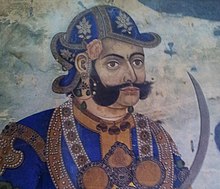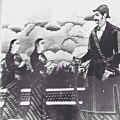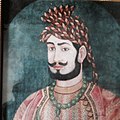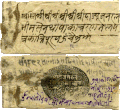Thapa dynasty
| Thapa dynasty थापा वंश/थापा काजी खलक Thapas of Borlang (Gorkha) | |
|---|---|
Birbhadra Thapa | |
| Current head | currently as pretender |
| Final ruler | Mathabarsingh Thapa |
| Titles |
|
Style(s) | |
| Estate(s) | Mathabar Singh Thapa) |
Thapa dynasty or Thapa noble family (
The Thapa family gave rise to the Rana dynasty of Jung Bahadur Kunwar Rana whose father Bal Narsingh Kunwar was the son-in-law of Kaji Nain Singh Thapa. Similarly, this dynasty was connected to the Pande aristocratic family through Nain Singh Thapa who was the son-in-law of once Mulkaji Ranajit Pande[8]
Background
The Thapa dynasty comes from the family of Kaji
The rise of Thapas (1743–1806)

The family became prominent during the rule of King
Thapas on power (1806–1837)

Thapas remained on political power from the military domination by Bhimsen Thapa. It was no secret that Bhimsen was able to maintain his supremacy due to the large standing army under his and his family's command. "...a race of men who for the last fifty-five years have dragged the country and its princes at the wheels of military car."[20]
The downfall of Thapas (1837–1839)


Bhimsen had committed atrocities against the Pande family by being involved in the execution of Nepalese Chief Kazi Damodar Pande. Rana Jang Pande, the youngest son of Damodar Pande, was a supporter of Senior Queen Samrajya Laxmi and had planned for the downfall of the thirty-one year Thapa rule.[21] In the Nepalese court, the rivalry between the two queens rose where the Senior Queen supported the Pandes, while the Junior Queen supported the Thapas.[22] Bhimsen went to his ancestral home in Gorkha for some time making Ranabir Singh Thapa as Acting Mukhtiyar.[23] Rana Jang Pande, the leading member of Pande aristocratic family and his brother, Ranadal Pande, was elevated in the Nepal Darbar.[24]
On 24 July 1837, King Rajendra Bikram Shah's infant son, Devendra Bikram Shah, died.[24][25] Bhimsen and members of the Thapa faction were blamed and conspired against.[25][26][27] On this charge, Bhimsen and whole the Thapa family, the court physicians, Ekdev and Eksurya Upadhyay, and his deputy Bhajuman Baidya, with relatives of the Thapas were incarcerated, proclaimed outcasts, and their properties confiscated.[25][26][28][29]
Fatte Jang Shah, Rangnath Poudel, and the Junior Queen Rajya Laxmi Devi, the anti-Pande faction, obtained from the King the liberation of Bhimsen, Mathabar, and the rest of the party, about eight months after they were incarcerated for the poisoning case.
The final chapter of Thapas (1843–1845)
The resurrection of Thapa

Mathabarsingh Thapa fled to India when Bhimsen Thapa and Thapa courtiers were punished.[32][35] Sher Jung Thapa and other jailed Thapa members were pardoned on the request of Junior Queen after the death of Senior Queen.[36] Mathabar, the most senior Thapa, was requested to return to Nepal by then ruling Junior Queen Rajya Laxmi after six years of exile.[37] Mathabarsingh Thapa arrived in Kathmandu Valley on 17 April 1843 where he was greeted with state honors.[38] He then re-opened the murder case of his uncle and godfather Bhimsen Thapa, and members of Pande faction and their supporters were executed.[39]
End of Thapas
The murder of Mathabar Singh on 17 May 1845 by his nephew,
Family palaces

The family resided at

Bagh Durbar, which literally means The Tiger's Mansion, was built in 1805 A.D. by PM Bhimsen Thapa. It had a spacious Janarala Bagh (General's Garden), a pond and many temples glorifying the Mukhtiyar General. When Thapa rule was revived, PM Mathabarsingh Thapa recaptured the lost palace and resided there for two years.[42]


The
Thapa family members
| No. | Members | Image | Position | Years ruled | Notes |
|---|---|---|---|---|---|
| 1 | Bhimsen Thapa |  |
Mukhtiyar ( Commander-in-Chief |
1806 to 1837 A.D. | |
| 2 | Ranabir Singh Thapa |  |
Acting Mukhtiyar (Acting Prime Minister)[23] | 1837 A.D. (briefly) | |
| 3 | Mathabarsingh Thapa |  |
Prime Minister and Commander-in-Chief | 1843 to 1845 A.D. | |
| 4 | Queen Tripurasundari of Nepal |  |
Queen Consort and Mother Regent of Nepal |
1805 to 1832 A.D. | |
| 5 | Bir Bhadra Thapa | Jetha Buda and Bhardar | He is the male patriarch of this dynasty and the senior Bharadar (politician) of the Gorkha Kingdom | ||
| 6 | Sanukaji Amar Singh Thapa |
Governor and Sardar | Distinguished from Commander of Western forces Badakaji Amar Singh Thapa by terms Bada (Senior) and Sanu (Junior) | ||
| 7 | Nain Singh Thapa |  |
General and Minister (Kaji) | ||
| 8 | Ujir Singh Thapa |  |
Governor and Colonel | son of Nain Singh Thapa[44] | |
| 9 | Bakhtawar Singh Thapa | Colonel | Brother of Bhimsen | ||
| 10 | Sher Jung Thapa | Colonel | Nephew and adopted son of Bhimsen | ||
| 11 | Amrit Singh Thapa | Kaji | Brother of Bhimsen, involved in bringing back Balbhadra Kunwar at Dehradun[45] | ||
| 12 | Ranzawar Thapa | Step-brother of Bhimsen | |||
| 13 | Ranabam (Bhotu) Thapa | Step-brother of Bhimsen | |||
| 14 | Tilak (Tri) Bikram Singh Thapa | Kaji | Known popularly as Kaji Mama by Shamsher Ranas; son of Bakhtawar Singh | ||
| 15 | Ranojjwal Singh Thapa | Son of Mathabarsingh Singh | |||
| 16 | Bikram Singh Thapa | Colonel | Son of Mathabarsingh Singh |
Family Tree of Bir Bhadra Thapa
| Bir Bhadra Thapa | |||||||||||||||||||||||||||||||||||||||||||||||||||||
| Jiwan Thapa | Bangsha Raj Thapa | Satyarupa Maya | Amar Singh Thapa (sanu) | ? | |||||||||||||||||||||||||||||||||||||||||||||||||
| Bhimsen Thapa | Nain Singh Thapa | Bakhtawar Singh Thapa | Amrit Singh Thapa | Ranabir Singh Thapa | Ranbam Thapa | Ranzawar Thapa | |||||||||||||||||||||||||||||||||||||||||||||||
| ? (son died young) | Lalita Devi Pande | Janak Kumari Pande | Dirgha Kumari Pande | ||||||||||||||||||||||||||||||||||||||||||||||||||
Family Tree of Kazi Singh Thapa
| Nain Singh Thapa | Rana Kumari Pande | ||||||||||||||||||||||||||||||||||||
| Ganesh Kumari Kunwar | Queen Tripurasundari of Nepal (born 1794) | Ujir Singh Thapa (born 1796) | Mathabarsingh Thapa (born 1798) | ||||||||||||||||||||||||||||||||||
| Ranojjwal Singh Thapa | Bikram Singh Thapa | Amar Singh Thapa II | Rana Abal Singh Thapa | Ranjor Singh Thapa | |||||||||||||||||||||||||||||||||
Other Thapa nobles
The unrelated family of Amar Singh Thapa was also included in broader Thapa caucus.[7]
| No. | Other Members | Image | Position | Years active | Notes |
|---|---|---|---|---|---|
| 1 | Badakaji Amar Singh Thapa | 
|
Kaji and General of Nepal | 1759–1816 AD | Distinguished from father of Bhimsen Thapa and Palpa Administrator Sanukaji Amar Singh Thapa by terms Bada (Senior) and Sanu (Junior)
|
| 2 | Bhakti Thapa | 
|
Sardar of Nepal Army | died 1815 AD | No blood relations to both Bhimsen Thapa and Badakaji Amar Singh Thapa |
| 3 | Ranadhoj Thapa | Deputy Prime Minister of Nepal | retired on 1831 | eldest son of Badakaji Amar Singh Thapa[48] | |
| 4 | Ranajor Singh Thapa | Kaji and Colonel of Nepal | youngest son of Badakaji Amar Singh Thapa[48] | ||
| 5 | Surath Singh Thapa | Kaji (later Captain only) and Joint-Chief signatory of Darbar[49] | appointed on 1832 | grandson of Badakaji Amar Singh Thapa | |
| 6 | Bhaktabir Thapa | Captain and later Kaji | retired on 1839 | second son of Badakaji Amar Singh Thapa[48] | |
| 7 | Narsingh Thapa | Captain and Kaji alternatively | appointed on 1818 | third son of Badakaji Amar Singh Thapa[48] |
Allies and opponents
List of Allies during Transition Phase (1837–1846)
| No. | Name | Type | Noted | |
|---|---|---|---|---|
| 1 | Ranganath Paudel |
Mostly allied | Known strong supporter of Bhimsen Thapa. | |
| 2 | Junior Queen Rajya Lakshmi Devi | Mostly allied but later switched alliance | Lastly, she supported attack on Thapas in 1845.[40] | |
| 3 | Fateh Jung Shah | Mildly allied | Supported the release of Thapas in 1837.[30] | |
| 4 | Gora Pande faction | Mild supporter | Known supporter and relatives of Thapa faction through Nain Singh Thapa. |
List of Opponents during Transition Phase (1837–1846)
| No. | Name | Type | Noted |
|---|---|---|---|
| 1 | Kala Pande faction | Strong opponent | Known strong opponent of Thapa faction. |
| 2 | Rajendra Bikram Shah and Senior Queen Samrajya Lakshmi Devi | Strong opponent | Known strong opponent of Thapa faction. |
| 3 | Basnyat family | Mild | Favoured Pandes over Thapas due to previous marital ties. |
| 4 | Kunwar family (Later Rana dynasty) | Former Alliance grew strong opponent. | Nephew Jung Bahadur Rana ended Thapa hegemony.[40] |
| 5 | Chautariya Pushkar Shah | Mild |
Favoured Pandes[50] over Thapas. |
| 6 | Brian Houghton Hodgson | Strong opponent but later sympathized. | Known strong opponent of Bhimsen Thapa but later sympathized Bhimsen.[51] |
Works

Dharahara tower was built by Mukhtiyar Bhimsen Thapa.[52] Dharahara is said to be built for Queen Tripurasundari of Nepal, who was the niece of Bhimsen Thapa.[53]
Gallery
-
Clothes worn by Mukhtiyar Bhimsen Thapa
-
Clothes worn by Mukhtiyar Bhimsen Thapa
-
Picture of Bhimsen Thapa standing beside a horse
-
PM Mathabar Singh Thapa in crown
-
Portrait of Mukhtiyar General Bhimsen Thapa
-
Portrait of first titled Prime Minister Mathabar Singh Thapa
-
Statue of Queen Tripurasundari
-
Portrait of Mukhtiyar General Bhimsen Thapa
-
Portrait of Colonel Mathabar Singh Thapa from 1831
-
Portrait ofMathabar Singh Thapa
-
Bhimsen Thapa and two wives
-
Mathabar Simha Thapa in Panjabi court
-
Portrait of Ranabir Singh Thapa
-
Portrait of Ujir Singh Thapa
-
Portrait of Ranabir Singh Thapa as Swami Abhayananda
-
Bhimsen Thapa,
-
General Ranabir Singh Thapa's letter signed by his private black seal sent to Mukhtiyar (PM) Bhimsen Thapa and 2nd Kazi (Deputy PM) Ranadhoj Thapa
-
Letter sent to PM Bhimsen Thapa and Kazi Ranadhoj Thapa by (Pvt. seal L to R) Bakhat Singh Sardar, Dalbhanjan Pande (Pande Kazi), Ranabir Singh Thapa, Kaji Narsingh Thapa (Elder Amar Singh Thapa's another son) and sundry captains
-
Letter sent to PM Bhimsen Thapa and Kazi Ranadhoj Thapa by then Colonel Mathabar Singh Thapa
See also
Notes
- ^ The family had their origins in Borlang village of Gorkha region to differentiate from another related Bagale Thapa family of Badakaji Amar Singh Thapa known as "Dynasty of Sirhanchowk" as originated from Sirhanchowk village in Gorkha region.
References
Citations
- ^ Whelpton 1991, p. 21.
- ^ a b c d e Pradhan 2012, p. 22.
- ^ ISBN 9788125005117. Retrieved 2017-06-11.
- ^ a b Joshi & Rose 1966, p. 23.
- ^ Joshi & Rose 1966, p. 25.
- ^ Pradhan 2012, p. 9.
- ^ a b Pradhan 2012, p. 26.
- ISBN 99933-39-91-1.
- ^ a b Pradhan 2012, pp. 22–23.
- ^ Pradhan 2012, pp. 21–22.
- ^ a b Pradhan 2012, p. 16.
- ^ Adhikari 2015, p. 120.
- ^ Acharya 2012, p. 3.
- ^ Acharya 2012, p. 71.
- ^ Acharya 2012, pp. 74–75.
- ^ Acharya 2012, p. 76.
- ^ Acharya 2012, p. 77.
- ^ a b Acharya 2012, p. 148.
- ^ Pradhan 2012, pp. 155–156.
- ^ Pradhan 2012, pp. 155.
- ^ Acharya 2012, p. 155.
- ^ Nepal 2007, p. 108.
- ^ a b Acharya 2012, p. 157.
- ^ a b Acharya 2012, p. 158.
- ^ a b c Nepal 2007, p. 105.
- ^ a b Acharya 2012, p. 159.
- ^ Whelpton 2004, pp. 28–29.
- ^ Acharya 1971, p. 13.
- ^ Oldfield 1880, p. 310.
- ^ a b Oldfield 1880, p. 311.
- ^ Nepal 2007, p. 109.
- ^ a b c Acharya 2012, p. 161.
- ^ Pradhan 2012, p. 164.
- ^ Nepal 2007, p. 110.
- ^ Oldfield 1880, p. 316.
- ^ Acharya 2012, pp. 172–174.
- ^ Acharya 2012, p. 177-178.
- ^ Sharma, Balchandra (1976). Nepal ko Aitehasik Rooprekha. Varanasi: Krishna Kumari Devi. p. 295.
- ^ Acharya 2012, pp. 179–181.
- ^ a b c Acharya 2012, pp. 11–12.
- ISBN 978-9994611027. Retrieved 12 May 2017.
- ^ "Baghdurbar – The Tiger Palace | The Tara Nights". thetaranights.com. Retrieved 12 May 2017.
- ^ "Kathmandu Valley | Places of Interest, Kathmandu, Bhaktapur, Patan City Tour, Typical City Tour , Unesco World heritage Sites Tour: Fishtail Tours & Travels Pvt. Ltd". fishtail.org. Retrieved 28 May 2017.
- ^ Hamal 1995, p. 206.
- ^ Pant 1978, p. 191.
- ^ Joshi & Rose 1966.
- ^ "History of the Nepalese Army". nepalarmy.mil.np. Archived from the original on 15 November 2017. Retrieved 18 June 2018.
- ^ a b c d Pradhan 2012, p. 195.
- ^ Pradhan 2012, p. 148.
- ^ Oldfield 1880, p. 313.
- ^ Whelpton 2004, pp. 29–30.
- ^ "Too tall for comfort". The Kathmandu Post. 11 January 2010. Archived from the original on 24 September 2015. Retrieved 25 April 2015.
- ^ Melissah Yang (25 April 2015). "Nepal Earthquake Destroys Dharahara Tower, A Significant Tourist Attraction In The Heart Of Kathmandu". Retrieved 25 April 2015.
Sources
- Acharya, Baburam (1 January 1971) [1962], "The Fall of Bhimsen Thapa and the Rise of Jung Bahadur Rana" (PDF), Regmi Research Series, 3 (1): 13–25, retrieved 31 December 2012
- Acharya, Baburam (2012), Acharya, Shri Krishna (ed.), Janaral Bhimsen Thapa : Yinko Utthan Tatha Pattan (in Nepali), Kathmandu: Education Book House, p. 228, ISBN 9789937241748
- Adhikari, Indra (12 June 2015), Military and Democracy in Nepal, Routledge, ISBN 978-1-317-58906-8
- Hamal, Lakshman B. (1995), Military history of Nepal, Sharda Pustak Mandir
- Joshi, Bhuwan Lal; Rose, Leo E. (1966), Democratic Innovations in Nepal: A Case Study of Political Acculturation, University of California Press, p. 551
- Nepal, Gyanmani (2007), Nepal ko Mahabharat (in Nepali) (3rd ed.), Kathmandu: Sajha, p. 314, ISBN 9789993325857
- Oldfield, Henry Ambrose (1880), Sketches from Nipal, Vol 1, vol. 1, London: W.H. Allan & Co.
- Pant, Mahesh Raj (1 December 1978). "The Battle of Nalapani" (PDF). Regmi Research Series. 10 (11, 12). Kathmandu: 167–170, 187–194. ISSN 0034-348X.
- Pradhan, Kumar L. (2012), Thapa Politics in Nepal: With Special Reference to Bhim Sen Thapa, 1806–1839, New Delhi: Concept Publishing Company, p. 278, ISBN 9788180698132
- Shaha, Rishikesh (1982), Essays in the Practice of Government in Nepal, Manohar, p. 44, OCLC 9302577
- Whelpton, John (1991), Kings, soldiers, and priests: Nepalese politics and the rise of Jang Bahadur Rana, 1830-1857, Manohar Publications, p. 315, ISBN 9788185425641
- Whelpton, John (2004), "The Political Role of Brian Hodgson", in Waterhouse, David (ed.), Origins of Himalayan Studies: Brian Houghton Hodgson in Nepal and Darjeeling, Royal Asiatic Society Books (1 ed.), Taylor & Francis, p. 320, ISBN 9781134383634



















